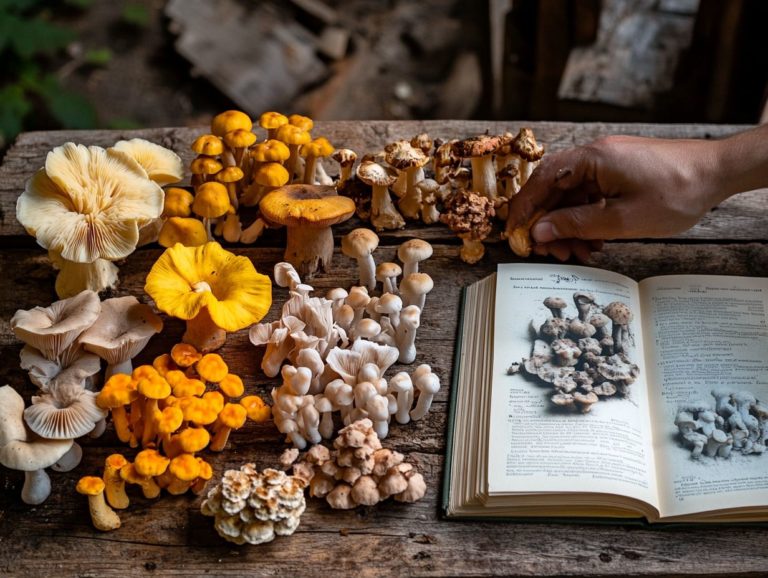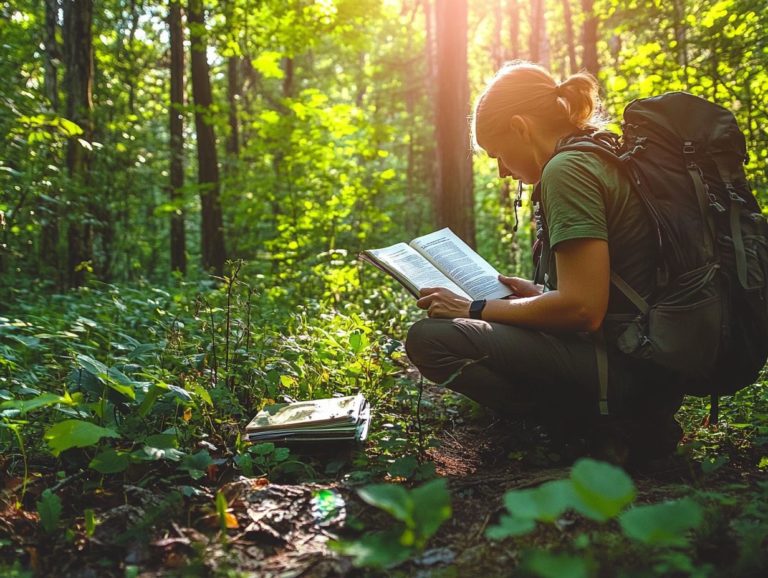5 Steps to Confidently Identify Wild Edibles
Foraging for wild edibles can be an exhilarating and fulfilling adventure, adding a fresh twist to your meals while deepening your connection with nature. Get ready to transform your meals with the vibrant flavors of wild edibles!
The secret to successful foraging lies in your knowledge and caution. This guide will walk you through five essential steps to help you confidently identify and enjoy safe, delicious wild plants.
You’ll also uncover potential risks, sustainable foraging practices, preparation methods, and the myriad health benefits of incorporating these natural treasures into your diet.
Contents
- Key Takeaways:
- 1. Educate Yourself on Local Edible Plants
- 2. Know How to Properly Identify Plants
- 3. Start with Familiar Plants
- 4. Use Multiple Sources for Verification
- 5. Always Err on the Side of Caution
- What Are the Potential Risks of Eating Wild Edibles?
- Frequently Asked Questions
- What are the 5 steps to confidently identify wild edibles?
- Why is observation the first step in identifying wild edibles?
- How does location play a role in identifying wild edibles?
- Why is it important to use your sense of smell and touch when identifying wild edibles?
- What are some reliable identification guides for wild edibles?
- Why is testing an important final step in identifying wild edibles?
Key Takeaways:

- Do your research and educate yourself on local edible plants before foraging. Always confirm plant identities using several trusted sources.
- Use caution when foraging for wild edibles and always err on the side of caution. Be aware of potential risks and practice sustainable foraging methods.
- Eating wild edibles can have many benefits, but it’s important to dispel common misconceptions. With proper education and caution, confidently identifying and incorporating wild edibles into your diet can be a rewarding experience.
1. Educate Yourself on Local Edible Plants
To embark on a meaningful foraging journey, you must educate yourself about local edible plants. Understanding their characteristics and seasonal availability will make foraging more enjoyable while ensuring safety and sustainability.
Recognizing these wild edibles not only connects you with nature but also offers a wealth of health benefits, from nutritional value to culinary variety. Pioneers like Sergei Boutenko and Samuel Thayer emphasize the importance of plant awareness, teaching enthusiasts to appreciate not just the flavor but also the environment from which these plants are gathered.
As the seasons shift, so does the array of wild edibles available, with common mallow and dandelions often gracing the landscape during spring. Knowing the unique growing patterns and potential uses of these plants elevates your knowledge and experience in foraging.
Respecting gathering etiquette is paramount; you’re encouraged to leave no trace, ensuring that future generations can also delight in these natural treasures. This mindful approach not only preserves ecosystems but also fosters a deeper respect for the environment, enriching your overall foraging experience.
2. Know How to Properly Identify Plants
Proper plant identification is essential for you as a forager. Accurately recognizing both edible plants and their dangerously toxic counterparts is crucial to avoid potentially life-threatening mistakes. Learning how to identify wild edibles during fall is not just important; it’s vital.
You can enhance your skills by employing techniques such as crushing leaves to discern their scent and understanding the key characteristics of young leaves. This not only sharpens your plant identification skills but also deepens your connection to nature.
Consider expanding your methods by observing the surrounding environment and consulting field guides for valuable contextual clues. To enhance your foraging skills, learn how to identify edible plants in the wild. The risks of misidentification are significant; consuming the wrong species can lead to serious health consequences or, in extreme cases, even be fatal.
Therefore, it s imperative for you to invest time in hands-on practice. Joining local foraging groups or workshops can provide you with invaluable firsthand experience. Modern technology provides several apps and databases that serve as convenient resources for learning and verifying plant identities, ensuring your foraging journey remains safe and rewarding.
Share your own foraging experiences or tips with others to enhance community engagement!
3. Start with Familiar Plants
When you embark on your foraging adventure, starting with familiar plants like common mallow and dandelions provides a sense of security. To enhance your knowledge, learning how to spot edible plants in the wild can help you build confidence in your foraging skills and safely identify plants.
These widely recognized wild edibles are safe and abundant during their harvesting seasons. They invite you to engage with nature while learning about the local ecosystem and its treasure trove of edible offerings. For those interested in foraging, check out these tips for identifying wild herbs.
Mastering the identification of these plants unlocks a world of culinary possibilities. They beautifully lend themselves to salads, smoothies, and cooked dishes. The mild flavor of common mallow enhances various recipes, while dandelion greens deliver a nutritious punch, brimming with vitamins A and C.
As you delve deeper into your local plants, take the time to educate yourself on the unique health benefits each offers, including wild mustard and stinging nettles. This knowledge fosters a richer appreciation for the food you gather.
This deepens your foraging experience and sparks creativity in the kitchen, transforming foraging into a fulfilling and enriching pursuit.
4. Use Multiple Sources for Verification

In the realm of foraging, utilizing multiple sources for verification is crucial. This approach ensures that the plants you gather are genuinely safe and edible. Relying on just one source can lead to significant mistakes.
Tap into resources like expert-authored books, such as those by Sergei Boutenko, online databases, and visual search image tools. By learning how to identify common wild edibles, you’ll sharpen your plant identification skills and boost your confidence as you explore wild edibles.
Exploring reputable websites and apps designed for foraging provides essential insights about geographical growing patterns and edible look-alikes. Engaging with local foraging communities can be incredibly beneficial; they share invaluable firsthand experiences and tips and tricks you won’t find in conventional literature or online.
By joining forums or attending workshops, you create opportunities for hands-on learning and safety discussions. This enriches your knowledge and appreciation for nature’s bounty while minimizing the risks associated with foraging.
5. Always Err on the Side of Caution
When you embark on the adventure of foraging for wild edibles, always prioritize caution. The risks associated with consuming unfamiliar plants can be serious, including the possibility of encountering highly poisonous plants that could lead to dire consequences. Prioritize safety and thoroughly research both edible plants and their toxic lookalikes to enhance your foraging adventures while minimizing the chances of adverse reactions.
For beginners, staying alert when foraging is crucial; one misidentified plant can lead to severe illness. To ensure safety, consider using a detailed guide on how to identify safe wild edibles. Here are some effective strategies for safe foraging:
- Taste testing small quantities of any new edible item helps gauge individual reactions without overwhelming your system.
- Consulting with seasoned foragers provides invaluable insights, as their firsthand experiences may reveal red flags to watch for.
Anecdotal evidence indicates that about 10% of novice foragers encounter mishaps due to misidentification, emphasizing the importance of education and caution in this rewarding yet potentially perilous pursuit.
Start your foraging journey today and discover the incredible flavors nature has to offer!
What Are the Potential Risks of Eating Wild Edibles?
Foraging for wild edibles offers great health benefits. However, it s important to be aware of the potential risks involved.
One significant danger is encountering highly toxic plants that can pose serious health threats. Understanding the balance between the rewards of harvesting these natural foods and the normal dangers is crucial for anyone eager to explore the abundant world of wild edibles safely.
Misidentification is a common pitfall that can lead to consuming harmful species. Reports indicate that nearly 10% of novice foragers mistakenly ingest toxic plants each year. This statistic is worth noting.
Allergic reactions to certain wild edibles can complicate matters, with some individuals experiencing severe symptoms.
To navigate these risks effectively, dive into thorough research. Utilize reputable field guides and online resources, and consider identifying safe edibles by participating in community workshops or local foraging groups.
This involvement enhances your knowledge and fosters mentorship with experienced foragers, creating a safer and more informed community around foraging.
How Can One Practice Sustainable Foraging?
Practicing sustainable foraging is crucial for preserving ecosystems. It encourages respect for nature and its inhabitants, including animal foragers, while gathering wild edibles responsibly.
By adhering to gathering etiquette and maintaining a keen awareness of plant species, you can ensure that your foraging activities do not adversely impact local biodiversity. This allows future generations to enjoy these natural resources.
Your responsibility includes techniques such as leaving enough plants to regenerate, which helps maintain healthy populations. For instance, by taking only what you need and leaving the rest, you support the growth of essential plant species like ramps and mushrooms, enabling them to flourish season after season.
Minimizing your environmental impact like avoiding trampling delicate habitats or foraging in protected areas fosters a more balanced ecosystem.
Sharing knowledge helps build a culture of stewardship, where everyone plays a part in preserving resources. Ultimately, a thriving foraging community rests on these principles, ensuring that wild edibles remain plentiful and sustainable for years to come.
What Are the Different Ways to Prepare Wild Edibles?

There are countless ways to prepare wild edibles like dandelions and stinging nettles. These methods not only enhance their flavors but also maximize their health benefits, allowing you to savor a truly rich culinary experience.
By exploring diverse cooking methods, from saut ing to infusing, you can transform these wild ingredients into delicious meals that celebrate nature’s bounty.
Incorporating techniques like blanching to reduce bitterness or dry saut ing to elevate flavor profiles enables you to craft dishes that highlight the unique characteristics of these plants. For instance, dandelion greens pair beautifully with a balsamic vinaigrette, while stinging nettles can be blended into vibrant pestos or soups.
Maintaining high nutrient retention is essential. Steaming or lightly steaming can help preserve their vital vitamins.
The versatility of these ingredients allows them to seamlessly blend into various cuisines, from Italian to Asian, offering endless opportunities for creativity in the kitchen.
With their rich nutrient profiles, wild edibles serve not just as a tantalizing addition but also as a significant boost to your overall health.
Start your foraging journey today by joining a local workshop!
How Can One Incorporate Wild Edibles into Their Diet?
Incorporating wild edibles into your diet can turn your meals into an exciting culinary adventure, sparking creativity and exploration. These natural ingredients showcase numerous health benefits and invite you to respect the balance of nature, much like animal foragers do in the wild.
From vibrant salads to invigorating smoothies, wild edibles elevate your meals, infusing them with unique flavors and nutrients straight from nature.
These vibrant ingredients introduce delightful variety to your common dishes, making it effortless to experiment with new flavors and textures. For instance, imagine adding dandelion greens to a refreshing salad; they provide a peppery kick while enhancing your intake of vitamins A and C.
Alternatively, consider blending wild garlic into your pesto for a fragrant twist on a classic recipe, bringing a fresh perspective to your pasta night.
By incorporating wild fruits like mulberries into your breakfast, you can boost the antioxidant content of your morning oats. Exploring these options diversifies your meals and enhances your overall nutrition, making wild edibles a truly worthwhile addition to your cooking skills.
What Are the Benefits of Eating Wild Edibles?
Eating wild edibles presents a wealth of benefits, offering high nutritional value and unique flavors that transform your dining experience. Foraging experts like Sergei Boutenko advocate for these natural ingredients, which deliver essential nutrients and deepen your appreciation for the environment and the food you consume.
Incorporating wild edibles into your daily meals brightens your plate with vibrant colors and distinctive tastes while packing a powerful punch of vitamins A, C, and K, alongside essential minerals like iron and calcium. These nutrient-dense foods are rich in antioxidants, which help combat oxidative stress (an imbalance between free radicals and antioxidants in your body) and potentially reduce the risk of chronic diseases.
Culinary enthusiasts who embrace foraged ingredients often find inspiration in crafting dishes that celebrate seasonal availability and promote a self-sustaining lifestyle. Harvesting these wild treasures honors nature’s cycles and nurtures a profound connection to the land.
What Are Some Common Misconceptions About Wild Edibles?
Many misconceptions surround wild edibles, causing confusion or hesitation for those interested in foraging. One prevalent myth is that all wild plants are unsafe to eat. Debunking these myths is crucial for fostering a deeper understanding of the health benefits and culinary potential that wild edibles can provide.
In reality, many wild plants are safe to eat and packed with vitamins and minerals. It’s a common mistake to think that edible plants are indistinguishable from toxic ones. However, with the right knowledge and guidance on foraging, you can develop the skills necessary to tell the difference.
Experts in botany and foraging emphasize that when you approach foraging with curiosity and caution, it unveils a treasure trove of flavors and health benefits. Actively seeking out local foraging groups or workshops will boost your confidence in identifying nutritious wild foods and help you appreciate the diverse ecosystems they inhabit.
Frequently Asked Questions

What are the 5 steps to confidently identify wild edibles?
- Observation
- Location
- Smell and touch
- Identification guides
- Testing
Why is observation the first step in identifying wild edibles?
Observation allows you to gather information about the plant, such as its appearance, surrounding environment, and potential hazards.
How does location play a role in identifying wild edibles?
The location of a plant provides clues to its identity, as certain plants thrive in specific environments.
Start incorporating wild edibles today to transform your meals into a vibrant culinary adventure!
Why is it important to use your sense of smell and touch when identifying wild edibles?
Your sense of smell and touch gives you vital clues about a plant’s safety. Many plants have unique smells or textures that help you recognize them.
What are some reliable identification guides for wild edibles?
Look for field guides, trusted websites, or local foragers for accurate identification. You can also explore 5 tips for quick wild plant identification; these resources can boost your confidence in foraging.
Why is testing an important final step in identifying wild edibles?
Testing a small piece of a plant is crucial. It helps you find out if it s safe to eat and if you might be allergic.






